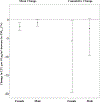Association between prenatal particulate air pollution exposure and telomere length in cord blood: Effect modification by fetal sex
- PMID: 30852452
- PMCID: PMC6511309
- DOI: 10.1016/j.envres.2019.03.003
Association between prenatal particulate air pollution exposure and telomere length in cord blood: Effect modification by fetal sex
Abstract
Introduction: In utero particulate matter exposure produces oxidative stress that impacts cellular processes that include telomere biology. Newborn telomere length is likely critical to an individual's telomere biology; reduction in this initial telomere setting may signal increased susceptibility to adverse outcomes later in life. We examined associations between prenatal particulate matter with diameter ≤2.5 µm (PM2.5) and relative leukocyte telomere length (LTL) measured in cord blood using a data-driven approach to characterize sensitive windows of prenatal PM2.5 effects and explore sex differences.
Methods: Women who were residents of Mexico City and affiliated with the Mexican Social Security System were recruited during pregnancy (n = 423 for analyses). Mothers' prenatal exposure to PM2.5 was estimated based on residence during pregnancy using a validated satellite-based spatio-temporally resolved prediction model. Leukocyte DNA was extracted from cord blood obtained at delivery. Duplex quantitative polymerase chain reaction was used to compare the relative amplification of the telomere repeat copy number to single gene (albumin) copy number. A distributed lag model incorporating weekly averages for PM2.5 over gestation was used in order to explore sensitive windows. Sex-specific associations were examined using Bayesian distributed lag interaction models.
Results: In models that included child's sex, mother's age at delivery, prenatal environmental tobacco smoke exposure, pre-pregnancy BMI, gestational age, birth season and assay batch, we found significant associations between higher PM2.5 exposure during early pregnancy (4-9 weeks) and shorter LTL in cord blood. We also identified two more windows at 14-19 and 34-36 weeks in which increased PM2.5 exposure was associated with longer LTL. In stratified analyses, the mean and cumulative associations between PM2.5 and shortened LTL were stronger in girls when compared to boys.
Conclusions: Increased PM2.5 during specific prenatal windows was associated with shorter LTL and longer LTL. PM2.5 was more strongly associated with shortened LTL in girls when compared to boys. Understanding sex and temporal differences in response to air pollution may provide unique insight into mechanisms.
Keywords: Bayesian distributed lag interaction models; Distributive lag models; Leukocyte telomere length; Particulate matter; Prenatal exposure.
Copyright © 2019 Elsevier Inc. All rights reserved.
Figures




Similar articles
-
Prenatal particulate air pollution and newborn telomere length: Effect modification by maternal antioxidant intakes and infant sex.Environ Res. 2020 Aug;187:109707. doi: 10.1016/j.envres.2020.109707. Epub 2020 May 21. Environ Res. 2020. PMID: 32474316 Free PMC article.
-
Identifying sensitive windows for prenatal particulate air pollution exposure and mitochondrial DNA content in cord blood.Environ Int. 2017 Jan;98:198-203. doi: 10.1016/j.envint.2016.11.007. Epub 2016 Nov 11. Environ Int. 2017. PMID: 27843010 Free PMC article.
-
Prenatal Air Pollution and Newborns' Predisposition to Accelerated Biological Aging.JAMA Pediatr. 2017 Dec 1;171(12):1160-1167. doi: 10.1001/jamapediatrics.2017.3024. JAMA Pediatr. 2017. PMID: 29049509 Free PMC article.
-
Exposure to ambient air pollution in the first 1000 days of life and alterations in the DNA methylome and telomere length in children: A systematic review.Environ Res. 2021 Feb;193:110504. doi: 10.1016/j.envres.2020.110504. Epub 2020 Nov 20. Environ Res. 2021. PMID: 33221306
-
Ambient air pollution and pregnancy outcomes: A comprehensive review and identification of environmental public health challenges.Environ Res. 2018 Nov;167:144-159. doi: 10.1016/j.envres.2018.07.008. Epub 2018 Jul 5. Environ Res. 2018. PMID: 30014896 Review.
Cited by
-
Air pollution and children's health-a review of adverse effects associated with prenatal exposure from fine to ultrafine particulate matter.Environ Health Prev Med. 2021 Jul 12;26(1):72. doi: 10.1186/s12199-021-00995-5. Environ Health Prev Med. 2021. PMID: 34253165 Free PMC article. Review.
-
Placental and Cord Blood Telomere Length in Relation to Maternal Nutritional Status.J Nutr. 2020 Oct 12;150(10):2646-2655. doi: 10.1093/jn/nxaa198. J Nutr. 2020. PMID: 32678440 Free PMC article.
-
The association of prenatal ambient air pollution with placental epigenetic gestational age at birth.Environ Epidemiol. 2025 May 5;9(3):e384. doi: 10.1097/EE9.0000000000000384. eCollection 2025 Jun. Environ Epidemiol. 2025. PMID: 40331055 Free PMC article.
-
Effect of Particulate Matter 2.5 on Fetal Growth in Male and Preterm Infants through Oxidative Stress.Antioxidants (Basel). 2023 Oct 26;12(11):1916. doi: 10.3390/antiox12111916. Antioxidants (Basel). 2023. PMID: 38001768 Free PMC article.
-
Prenatal Household Air Pollution Exposure, Cord Blood Mononuclear Cell Telomere Length and Age Four Blood Pressure: Evidence from a Ghanaian Pregnancy Cohort.Toxics. 2021 Jul 14;9(7):169. doi: 10.3390/toxics9070169. Toxics. 2021. PMID: 34357912 Free PMC article.
References
-
- Asghar M, et al., 2015. Hidden costs of infection: Chronic malaria accelerates telomere degradation and senescence in wild birds. Science. 347, 436–438. - PubMed
-
- Bijnens E, et al., 2015. Lower placental telomere length may be attributed to maternal residential traffic exposure; a twin study. Environment International. 79, 1–7. - PubMed
Publication types
MeSH terms
Substances
Grants and funding
LinkOut - more resources
Full Text Sources
Other Literature Sources
Medical

